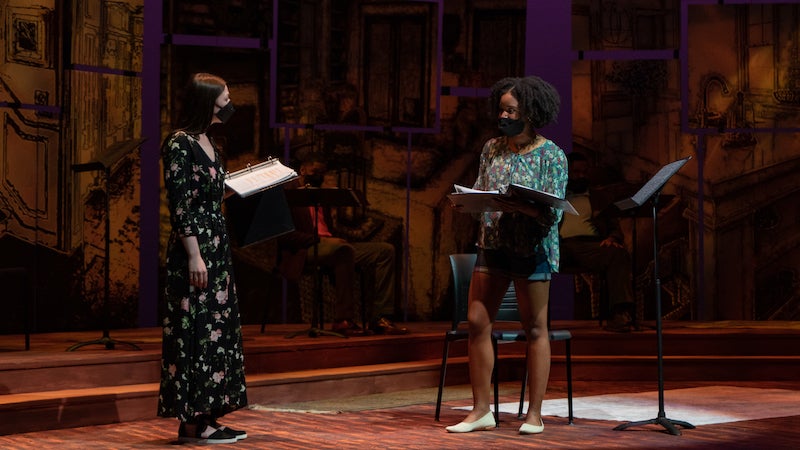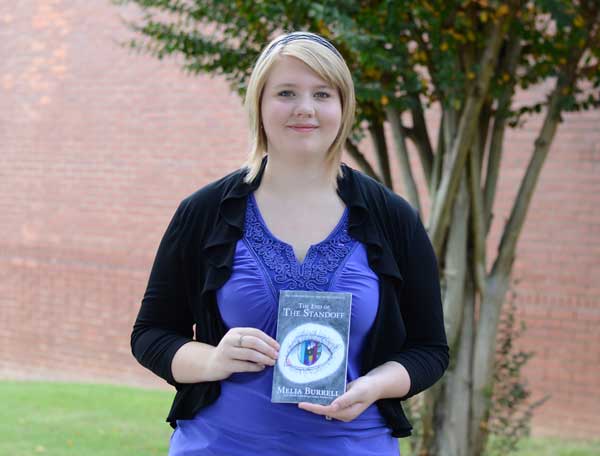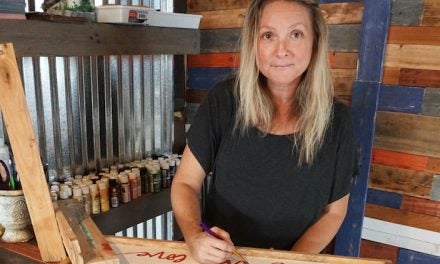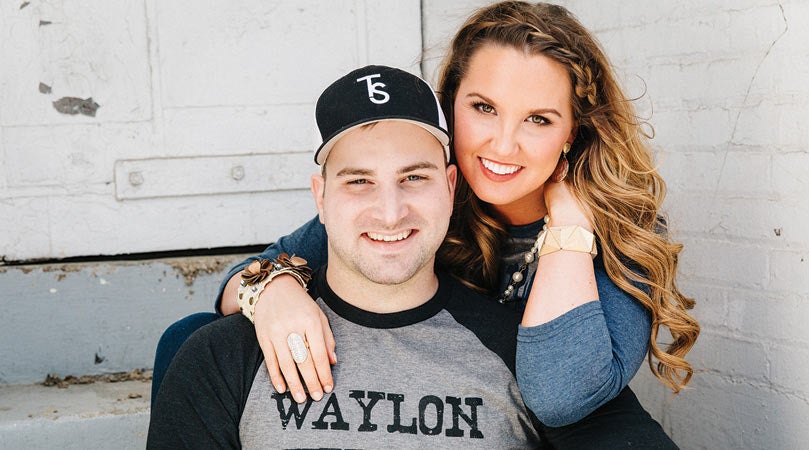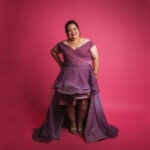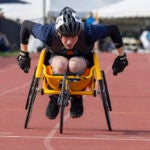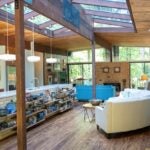By Lauren H. Dowdle
Photos by Jessica Sullivan
Like much of what happened in the past year, the University of Montevallo’s latest theatre production didn’t quite look like “normal.” For their first production since the start of the pandemic, Stick Fly by Lydia R. Diamond tackled issues of gender, class, race and privilege in a searing way—all performed with masks and social distance.
The play was directed by guest artist Chalethia Williams from Miles College, and to learn more about the experience we talked with her as well as Emily Gill, costume designer and associate professor of theatre and costume design, and Labrina Riles, a senior theatre major who played Taylor Bradley-Scott.
What did you enjoy most about your role in Stick Fly?
Labrina: My favorite part was getting to embody someone who was has the same ethnicity as me. I didn’t have to imagine what it would be like if the character was black. She already was, and that was a freeing and validating experience to play someone who is like me and discusses the black experience.
Emily: My favorite part of every show is to talk with directors and performers — what they think, what work they are doing, what images or other materials inspire them. What was most enjoyable and valuable about Stick Fly particularly was director Chalethia Williams’s perspective on the story, characters and process.
Chalethia: My favorite part was working with all of the students and faculty to see this production through to closing night. And that new space is fantastic (read more about it in the sidebar).
How did this production look different than usual during COVID times?
Labrina: The production was a full-staged reading. A staged reading is like doing a full show but with the scripts on stage with limited movement. We still had costumes, but spacing was mostly 6 feet, wearing masks—which are very hard to articulate in — and there were no shared props at all.
Chalethia: The look was different in that the characters had no physical contact, and it was billed as a stage reading to let audiences know that it would look different. So, the audience had to work harder to see the picture that the actors were working just as hard to make them see only, for the most part, through the words of Ms. Diamond.
Emily: In terms of the creative process, not very different. In terms of realization, there were some special considerations with reference to a number of changes. This is the type of play where, traditionally, the costumes not only define characters in place, but the changes in family dynamics over the course of the long weekend. I made the call early that student-crew-assisted changes were out. Something that was missing to a degree is the pre-show environment for performers. Usually, they can warm up together, chat, run lines—and the energy translates to stage. After the rehearsal weekend, seeing how glum it was compared to the usual excited environment, we found a nice space where they could gather properly distanced to try to bring some of that back.
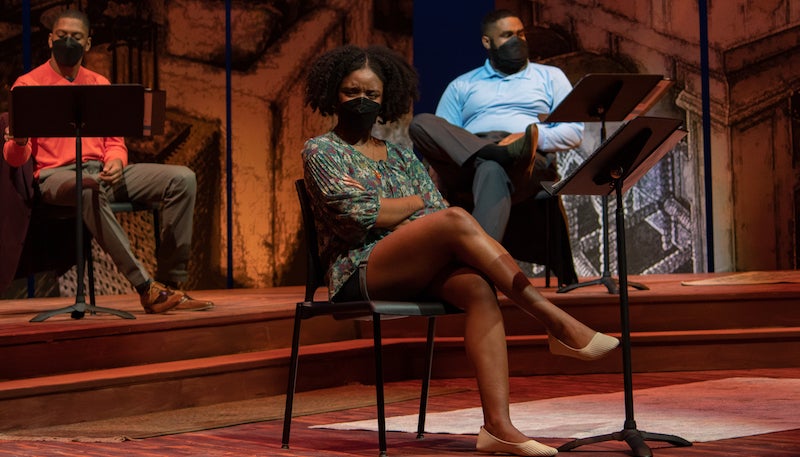 Conversely, how did the production look similar to productions from pre-COVID times?
Conversely, how did the production look similar to productions from pre-COVID times?
Labrina: Honestly, I was so amazed at the set and costumes. In usual staged readings, you don’t get a full set, and you’re usually dressed in all black. The costumes, set and lights truly brought it together for the audiences to be able to imagine our full world.
Chalethia: The similarities were that the words are the words with or without moving —or blocking, as it is called. So, the task was to direct the students to paint the picture with the dialogue more through their delivery, some body movement and above-the-mask gestures. I used the term, “eye acting.” It was a bit of a challenge, but I felt that as long as the students believed and committed to the story, the audience would believe and get it.
Emily: The students working on the production, performing and in the department at large worked and supported the staged reading the same as a full production. I’m not surprised because of the type of student we have at UM Theatre, but I think given the extended energies needed to complete classes, extra steps for prep, extra calls and all kinds of new processes, it would have been easy to relax, but they didn’t.
What do you hope audiences left thinking or feeling?
Labrina: There are so many small gems in the story that bring up class dynamics, race, interracial dating, identity and familial turmoil. Overall, I hope we told the story well enough to where each audience member left taking a piece from the story that made them either want to evaluate their own thinking of people or gave them something to hold onto every day as they go through life. Personally, two of those takeaway moments happened with the dad character. He says, “Find a man that hasn’t made mistakes and then you judge,” and, “No one can make you feel inferior.”
Emily: I hope they learned a new author to seek out in future plays to attend and read. I hope that audiences felt represented by the stories and images we created collaboratively. I hope everyone expanded their knowledge of modern social discussions and continued those discussions after leaving our building, and finally, I hope they enjoyed the performances.
Chalethia: I hope the audience left with the story and the history of the story written by Ms. Diamond. And that little or nothing was missed because of the masks because staged readings are not a new concept.
What are you most excited about with future performances that will be held during post-pandemic times?
Emily: I hope we don’t abandon virtual access events because I feel a positive effect of this situation is in more remote areas. We have access to a greater diversity of content and forms. I hope we can remember the positive aspects of being apart when we are together again and not just return to only the accidentally exclusive models out of nostalgia.
Labrina: There are so many ways people have continued to keep creating work, but safely and differently than before. I can’t wait to see how it influences a new era of live theatre.
Chalethia: I am excited to see how the return to some type of normalcy happens and how the theatre and audience have to adjust. I have no doubt that theatre will return, but I think it will look different.
A Stage with a Story
The University of Montevallo opened its new Center for the Arts in time for fall classes last year. The 36,750-square-foot building serves students in the College of Fine Arts department, including art, music and theatre, communication and dance — something senior Labrina Riles is especially excited about. “I’m also a dancer, so now having access to a dance facility is so helpful for putting dance reels together and just improving technique,” Labrina says.
The new center gave classes the space needed to provide socially distant learning options, says Emily Gill. It also provided room backstage that COVID protocol required for the Stick Fly production. “It’s more than ‘creature comforts’ we gained in this building. It was the ability to operate at all,” Emily says. “I think there was some wincing at opening a giant gathering space just in time for gatherings to be restricted, but in truth, it was ‘right on time’ in the local parlance.”
The stage in the Center of the Arts will be named after alumna Rebecca Luker, a UM graduate who led a lengthy career as a Broadway actress. Rebecca, who passed away in 2020, earned multiple Tony Award nominations for her roles, while also remaining involved with UM. “I think her approach to her art with dedication, sensitivity, and — later after her successes — a sense of lifting up those on the rise are qualities we can emulate in all disciplines,” says Emily, who remembers hearing Rebecca’s commencement address at UM.

